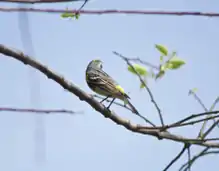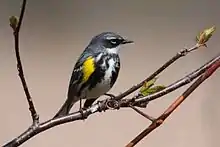Myrtle warbler
The myrtle warbler (Setophaga coronata coronata) is a small New World warbler.

| Myrtle warbler | |
|---|---|
 | |
| Scientific classification | |
| Kingdom: | Animalia |
| Phylum: | Chordata |
| Class: | Aves |
| Order: | Passeriformes |
| Family: | Parulidae |
| Genus: | Setophaga |
| Species: | |
| Subspecies: | S. c. coronata |
| Trinomial name | |
| Setophaga coronata coronata (Linnaeus, 1766) | |
| Synonyms | |
| |
The myrtle warbler has a northerly and easterly distribution, with Audubon's further west. It breeds in much of Canada and the northeastern USA. It is migratory, wintering in the southeastern United States, eastern Central America, and the Caribbean. It is a rare vagrant to western Europe, and has wintered in Great Britain.
The summer male myrtle warbler has a slate blue back, and yellow crown, rump and flank patch. It has white tail patches, and the breast is streaked black. The female has a similar pattern, but the back is brown as are the breast streaks.
The myrtle can be distinguished from Audubon's warbler by its whitish eyestripe, white (not yellow) throat, and contrasting cheek patch. Their trill-like songs, nearly indistinguishable, consist of a 3–4 syllable "tyew-tyew-tyew-tyew", sometimes followed by 3 more "tew"'s. The call is a hard check.
Its breeding habitat is a variety of coniferous and mixed woodland. Myrtle warblers nest in a tree, laying 4–5 eggs in a cup nest.
These birds are insectivorous, but will readily take wax-myrtle berries in winter, a habit which gives the species its name. Experienced birders recognize myrtle warblers with the naked eye by their flycatcher-like habit of making short flights from their perch in search of bugs. They form small flocks on migration or in winter.
Taxonomy
This passerine bird was long known to be closely related to its western counterpart, Audubon's warbler, and at various times the two forms have been classed as either one species or two. At present, the American Ornithological Society considers the myrtle and Audubon's warbler two subspecies of the Yellow-rumped warbler (Setophaga coronata coronata and Setophaga coronata auduboni, respectively) while the IOC World Bird List classifies the myrtle warbler and Audubon's warbler as separate species (Setophaga coronata and Setophaga auduboni). The two forms most likely diverged when the eastern and western populations were separated in the last ice age. In North America, the two forms are now again officially recognized as conspecific.[1]
References
| Wikimedia Commons has media related to Dendroica coronata. |
- Kaufman, K., Kaufman Field Guide to Birds of North America, New York:Houghton Mifflin Books, 2000.
- New World Warblers by Curson, Quinn and Beadle, ISBN 0-7136-3932-6